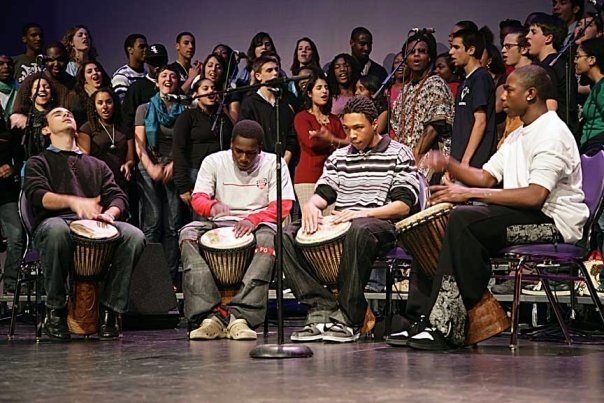The interplay between music and spirituality has long been acknowledged as a profound phenomenon, transcending cultural and religious boundaries. In the Bahá’í Faith, the role of music is explicated not only as an artistic expression but as a vital spiritual force, particularly among the youth. This exploration delves into the theme of “Bahá’í Youth Sing for Joy,” elucidating how music acts as a conduit for spiritual growth, connection, and community within the Bahá’í community. Several dimensions merit consideration in this multifaceted dialogue: the nature of music within Bahá’í teachings, various musical forms embraced by the Bahá’í community, the impact of music on youth identity, and the universal messages music conveys.
Music, in the Bahá’í perspective, is often regarded as a divine gift, intricately linked to the quest for truth and spiritual elevation. The founder of the Bahá’í Faith, Bahá’u’lláh, extolled the power of music as a medium to elevate one’s soul, encouraging the pursuit of artistic endeavors as a means of fostering joy and unity. Within the framework of Bahá’í teachings, music is not merely an aesthetic endeavor; it is a spiritual practice that harmonizes the individual with the divine and the community. This understanding positions musical expression as an essential practice among Bahá’í youth, allowing them to channel their emotions and spirituality into a collective experience that enhances communal bonds.
Examining the types of music embraced by the Bahá’í community reveals a rich tapestry of cultural influences. The Bahá’í writings encourage the appreciation of diverse musical traditions, recognizing that each form embodies unique spiritual and cultural elements. From traditional folk melodies to contemporary spiritual songs, the Bahá’í youth participate in a broad spectrum of musical expressions. They often engage in folk songs that celebrate love, unity, and the principles of the Faith, as well as original compositions that articulate their personal spiritual journeys and aspirations. This eclectic embrace of music serves not only to maintain cultural linkages but also to foster a sense of belonging and inclusion among diverse backgrounds.
One particularly profound aspect of music in the Bahá’í community is its capacity to forge identity among the youth. As young Bahá’ís navigate the complexities of adolescence, music serves as a powerful form of self-expression. It empowers them to articulate their innermost feelings, aspirations, and challenges in a manner that resonates with their peers. This musical expression is often found at gatherings such as Holy Days, youth conferences, and community events, where songs become a shared language that fosters understanding and inclusivity. The act of creating and sharing music can significantly bolster self-esteem and individual confidence, while serving as a reminder of their shared values and collective purpose.
The capacity of music to convey universal messages is another dimension worth exploring. In a world often beset by conflict and division, the Bahá’í emphasis on the oneness of humanity finds resonance within musical expression. Songs that extol themes such as the importance of unity, justice, love, and compassion serve to remind listeners of their interconnectedness. These universal themes transcend cultural barriers and speak to the intrinsic human yearning for connection and understanding. Consequently, the Bahá’í youth, through music, become instruments of change, fostering harmony in their communities and advocating for collective progression.
Moreover, music within the Bahá’í context is often employed as a tool for education and outreach. Engaging in musical endeavors enables young Bahá’ís to articulate the core principles of their Faith in an engaging manner. They participate in musical education programs that are tailored to deepen their understanding of spiritual concepts and enhance their artistic skills. The synergy of learning about the Bahá’í teachings through music cultivates a unique platform for evangelism, wherein youth can share their beliefs through the universal language of song, making the principles of the Faith accessible to a broader audience.
Another noteworthy aspect of music as a spiritual force is its potential to inspire and mobilize youth for social action. In an atmosphere that encourages service, music often becomes a rallying cry for social justice initiatives and community development projects. Bahá’í youth often utilize their musical talents to fundraise for humanitarian efforts, raise awareness of pressing social issues, and motivate their peers to engage in meaningful service. In this sense, music transcends the role of mere entertainment; it becomes a catalyst for positive societal change and a vehicle for instilling a sense of responsibility and purpose.
Additionally, the importance of mentorship in fostering musical expression within the Bahá’í community cannot be overstated. Experienced musicians within the community often take it upon themselves to mentor younger individuals, providing support, guidance, and training. This mentorship cultivates not only artistic skills but also nurtures spiritual growth among the youth, creating a legacy of artistic expression that bridges generations. Such relationships not only enhance musical proficiency but also instill values that align with the aspirations of the Bahá’í community, further reinforcing the interconnectedness between music, spirituality, and community life.
In conclusion, the integration of music as a spiritual force within the Bahá’í community illuminates its multifarious dimensions. The experience of “Bahá’í Youth Sing for Joy” encapsulates the transcendental capacity of music to uplift the soul, forge identity, and promote unity among individuals. Through diverse musical expressions, Bahá’í youth articulate their spirituality, engage in collective service, and inspire their communities toward greater harmony. As they continue to explore the intricate relationship between music and spirituality, they reaffirm the transformative potential embedded within each note and lyric—a noble pursuit aligning with the Bahá’í principle of universal peace and the oneness of humanity. By embracing the essence of music, they contribute their voices to a larger symphony that reverberates through the ages, transcending time and space, and elevating human consciousness toward spiritual enlightenment.
